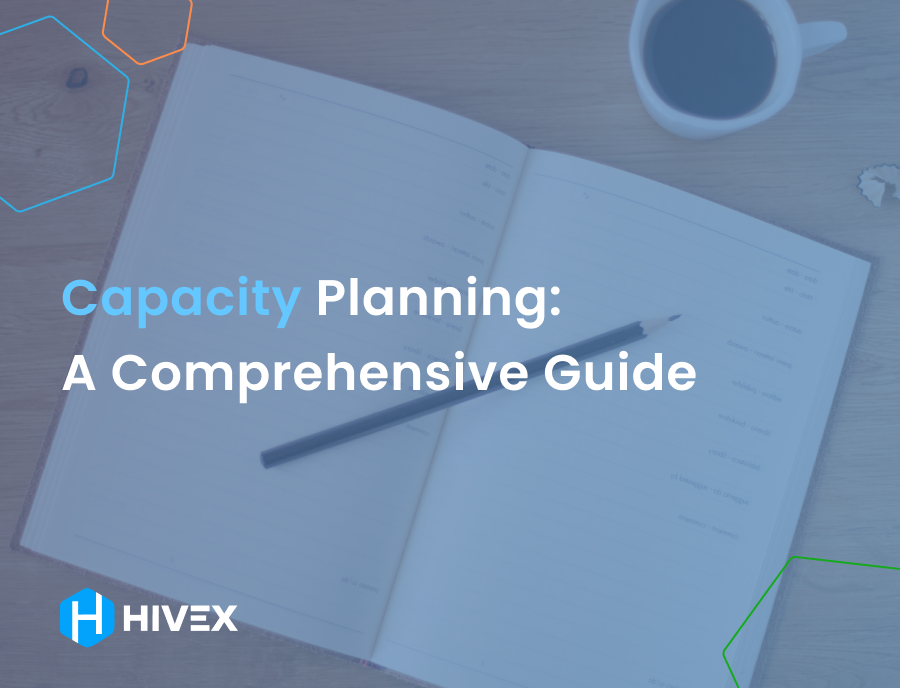Capacity Planning: A Comprehensive Guide

Successful startups start with a great idea and a solid plan. To scale up efficiently and effectively, startups need to plan for capacity. In this blog post, we’ll cover the key steps to developing a capacity plan for your startup.
We’ll discuss the importance of capacity planning, the benefits it can provide, and what to consider when creating one. Throughout the course, we’ll discuss assessing current workloads, determining skills, evaluating resources, analyzing infrastructure, and developing workforce capacity planning roadmaps. Finally, we’ll explain how to implement and monitor your capacity plan.
What is capacity planning?

As the name suggests, capacity planning involves determining the amount of resources and time needed to achieve a goal. Startups must understand capacity planning to reach their business goals. The process tool capacity planning involves assessing current workloads, forecasting future needs, and figuring out how much time and resources each task will require.
By using this process, businesses can ensure that they are getting the most out of their resources and make informed decisions.
When startups understand capacity, they can maximize opportunities and plan for growth. By planning capacity, they can determine which tasks need to be accomplished, how many resources they need, how much those resources will cost, and when they should be completed.
They can then plan and allocate resources appropriately while avoiding bottlenecks or other issues that could delay progress by accurately assessing the types of capacity planning and the scope of projects.
To identify potential capacity constraints, businesses must also analyze current workloads and project future needs. As a result, businesses can effectively manage demand against supply and ensure they have the right tools in place. It’s important to create a capacity plan for any startup that is looking to expand into a new market but does not have the necessary staff or technology in place yet.
For startups looking to scale up efficiently and controllably, capacity planning is crucial. The most effective way to resource capacity planning and set yourself up for success both now and in the future is to understand your business’s current needs and projected growth areas. You should develop a plan accordingly.
Why Capacity Planning is Essential for Startups

For startups to manage resources and grow, capacity planning is essential. As a result, organizations can forecast their future needs accurately and decide when to scale up or down based on a clear framework. By allowing businesses to respond to changes in market dynamics or customer demands, it prevents costly mistakes.
Additionally, a capacity plan helps teams stay focused on their goals without getting overwhelmed by competing priorities, offering clarity and organization around how resources are allocated.
Moreover, automating mundane tasks with tools like Dialpad’s AI assistant and outsourcing certain operations helps save time while still providing access to specialized skillsets at scale – an opportunity every startup should take advantage of!
Lastly, capacity planning makes sure businesses with limited budgets have enough resources when they need them.
A tailored capacity plan that meets all of the startup’s current and future needs can help startups stay competitive in an ever-evolving business landscape by setting them up for success now and in the years to come.
Benefits of Effective Capacity Planning Process
The most important benefit of effective capacity planning is that it can help startups reduce costs by optimizing resource usage. Startups can keep costs down by allocating resources efficiently and cost-effectively completing tasks with careful capacity planning strategies.
By understanding their current workloads and future projections, startups can better anticipate customer demands and allocate resources accordingly. Meeting customer expectations on time increases customer loyalty and satisfaction.
Using capacity plans to prioritize tasks and allocate resources accordingly can increase productivity for startups. This helps them get more done with fewer resources. By doing so, they can maximize the time of their team while remaining competitive.

Furthermore, capacity planning reduces risks associated with the overallocation of resources by ensuring teams have enough personnel on hand without overstaffing or understaffing. By doing so, projects will be completed on time, and resource wastage or fatigue will be avoided due to over-allocation or under-allocation.
As a final benefit, effective capacity planning enables teams to respond faster and efficiently because they know exactly how many staff they need for each task or project in advance, rather than having to figure out how many staff they need when faced with an unexpected situation.
The startup can ensure that it is always capable of responding quickly if needed by having adequate personnel on hand when needed, without experiencing any delays due to staffing constraints or resource waste due to over-allocation.
If startups want to grow and stay competitive, capacity planning is essential because it helps them optimize their resources so they maximize opportunities while also reducing costs associated with inefficient personnel or resource allocation.
In addition, we can respond quickly to customer emergencies or unexpected situations without experiencing delays due to staffing excess capacity constraints.
Factors to Consider in Resource Planning
A startup team’s capacity planning process can be particularly challenging due to the various factors that need to be considered. When formulating their capacity plan, organizations should consider the organization structure, resources available, workload forecast, budget, and risk management.
Capacity planning relies on organizational structure because it determines how each company team interacts with the others and which resources are allocated. Any future changes that may influence resource allocation or limit productivity levels need to be considered as well as the size and scope of each team.
Availability of resources is another aspect of capacity planning that needs to be evaluated since it determines what personnel or external solutions are required to meet growth targets. As well as reviewing their current staff’s skillset, startups should identify freelancers or contractors who might be able to provide additional support.
To plan capacity effectively, startups need to forecast their current workload over time so they know which areas need more resources. As a result, they can set realistic goals based on their budget while still considering the risks associated with overextending or understaffing certain parts of their business.
To scale up capacity, budgeting is crucial because it determines how much money can be spent on hiring new staff or purchasing new equipment and software. Budgets should be realistic and take into account any potential risks associated with overspending or underspending in specific areas.
As a final point, risk management should always be considered when preparing a capacity plan, as unexpected changes such as customer demand fluctuations could cause major disruptions. Before scaling up production capacity for growth, startups should identify all potential risks associated with expanding too fast or not having enough resources.
Assessing Current Workload and Projected Growth

Startups need to have a capacity plan as they grow. Identifying future project demands, assessing existing infrastructure and technology resources, and evaluating business processes for scalability are essential.
One can gain insight into future success by analyzing staff workloads. Surveys and focus groups should be considered along with industry trends that might affect demand levels to accurately estimate or predict these demands. The availability and skill sets of the right people must also be reviewed to ensure sufficient time is available for tasks to be completed.
Additionally, businesses need to keep their infrastructure and technology resources up-to-date, including computers and software programs. It is also crucial to examine whether their customer service protocols are scalable with future orders and requests.
Startups can maximize resource utilization while minimizing risks associated with over-allocating personnel and supplies by carefully assessing current workloads and projecting growth needs ahead of time.
Your business will succeed with a capacity plan!
Evaluating Resource Management
A startup’s resource allocation strategy ensures that the right people are doing the right work at the right time as it grows. Identifying redundancies and areas that need additional training or support is important. Also, job roles and responsibilities should be analyzed to ensure they are needed and are being filled by appropriate candidates.
To measure team performance, startups can use metrics like customer feedback ratings or task completion times to determine if more staff is needed. To ensure all roles are filled with qualified individuals with experience in their fields, existing team size and skillset should be evaluated. These steps help startups maximize resources without overstretching budgets.
Determining the Skill Requirements
When businesses expand, it is important to know what skills are needed for each position. Identifying any gaps in knowledge or expertise in the current staff can help determine if more training is needed. As recruitment decisions are influenced by qualifications and duties, job descriptions should be carefully designed. Keeping up with industry trends and tech changes can also help predict future skills.
An accurate assessment of employee skills helps companies hire the right people. Rather than trying to teach existing employees, it may be better to hire an outside contractor with specific technical experience if some employees are proficient in customer service but lack technical know-how. In this way, everyone is proficient and experienced at the right level.
Read more: Top 15 Sites to Hire Great Remote Developers in 2024
Understanding current workloads, resource availability, budgetary limitations, technological capabilities, and team skill sets is critical to capacity planning. As an organization scales up capacity in a startup environment, it can capitalize on opportunities and avoid risks associated with over-allocation or under-preparedness due to insufficient abilities or infrastructure.
Analyzing Infrastructure and Technology Needs
Startups need to evaluate infrastructure and technology needs comprehensively to scale capacity. Identifying any gaps in the existing set-up then allows them to research solutions that bridge those gaps. The creation of a roadmap will help break down tasks and track milestones over time to ensure successful implementation. It is critical to stay on top of industry trends to meet customer expectations and stay competitive. Businesses can maximize resources without straining budgets or service quality by considering these steps when planning capacity.

Steps to Develop a Capacity Plan
An organization must analyze its current workloads and capabilities, and anticipate future project demands, to create a successful capacity plan. Identifying potential capacity constraints includes evaluating existing infrastructure and technology resources, taking customer feedback into account to estimate future demand, and capacity requirements, and ensuring the right people are on board with the appropriate skills.
Following an assessment of resources, it is important to review allocation to maximize them without overspending. Utilizing metrics to measure team performance, analyzing resources, designing job descriptions specific to the role being filled, staying on top of industry trends and technological changes when hiring new employees (such as recruiting external contractors with relevant experience), etc.
Furthermore, businesses should evaluate their current resources/infrastructure to identify any gaps in what they need before researching solutions to bridge these gaps. The roadmap should also include planned upgrades to remain competitive while maximizing available resources without compromising quality.
To determine capacity constraints going forward, companies must examine the workloads, skills, and resources required for growth, along with existing infrastructure/technology requirements. This is before taking further steps towards scaling up wisely.
Following these steps when developing a capacity plan will assure businesses of making informed resource utilization strategy planning decisions and setting themselves up for success rather than failure down the road.

Step 1: Identify and Prioritize Business Goals
The first step to growing a startup is to identify and prioritize its business goals. Assessing current resources, analyzing market trends and customer segments, and familiarizing oneself with company mission statements and growth strategies are all part of this process. In addition to providing an overview of the company’s target market, this information provides insight into the company’s future goals and lead strategy.
Keeping up with industry news can help uncover areas for improvement for further development. Introducing cutting-edge technologies or innovative services may open growth opportunities. To prevent teams from being overburdened by unrealistic expectations or deadlines set too soon after launch dates, it is essential to assess existing resources. It is also essential to understand what can be achieved within the available budget and timeframes.
Taking all factors into account, it is necessary to develop a capacity plan that makes efficient use of resources. This is while remaining within budget, timeline, and personnel constraints. As a result, startups can maximize their resources without overstretching budgets or straining service quality.
Step 2: Gather Data on Existing and Future Projects
For capacity planning, we will discuss gathering data on existing and future projects. For accurate assessment of resources needed, forecasting demand for new and existing products or services, and identifying potential risks, data collection is crucial.
To determine how many staff members are needed, it is necessary to evaluate current projects and identify resources. Researching industry trends helps predict potential changes that could affect business capacity needs. In addition, it analyzes customer and stakeholder feedback. Therefore, you can prepare for any upcoming changes in advance.
Another key component of a capacity planning strategy is forecasting demand. Businesses can better allocate resources if they anticipate the demand for services or products. Prepare mitigation strategies if necessary by assessing potential risks associated with each project.
When you gather all the data related to your startup’s current and future projects, you can use it to create an effective capacity plan. Besides ensuring your business has enough resources at all times, it will also provide you with a better understanding of your market niche opportunities.
Step 3: Conduct a Resource Analysis
An in-depth resource analysis is crucial to scaling a startup, which involves evaluating existing staff, assets, and technology. To reach capacity goals, startups need to assess skills or resource gaps. It’s critical to consider the cost of hiring or contracting with external experts when acquiring qualified personnel.
Resource analysis should also include checking current infrastructure requirements, finding potential barriers to plan implementation, and then searching for solutions. Having a roadmap based on realistic goals and objectives is also key; startups should stay informed about industry trends so they can adjust their plan accordingly.
The roadmap must also be reviewed against milestones and risks evaluated to develop mitigation strategies. The right resource analysis upfront ensures businesses have all the resources they need to scale successfully while staying within budget constraints.
Step 4: Define Capacity Constraints
Startups should assess both their availability of resource capacity and utilization of resources when creating a capacity plan. A capacity constraint is a limitation imposed on these resources that must be considered to scale successfully.
For quality and customer experience to be maintained, it is essential to analyze the current and future demands of these resources within these limits. It will be easier to understand what can be done with limited resources if assumptions are documented about resource availability and capacity.
Managing capacity constraints effectively involves considering strategies such as outsourcing activities or projects that require specialized skill sets. It also requires automating processes when possible and creating flexible staffing plans. When scaling, tracking progress against milestones will help determine if resources or timing need to be adjusted.
These considerations will help startups form an agile business model that maximizes profitability and customer satisfaction while allowing them to scale up smartly.
Step 5: Develop a Capacity Roadmap
Developing a capacity roadmap is crucial for fledgling companies. To ensure that goals are accomplished on time and within budget limits, it is vital to factor in the organization’s mission statement and development strategies after gathering data from the prior steps, which include resource assessment, project evaluation, and risk calculation.
You can single out the necessary resources as well as prioritize tasks properly when you construct a capacity roadmap by formulating precise objectives and targets for it to accomplish. Determine how much personnel, technology, assets, materials, and services you will need once your ambitions have been specified. Ensure you understand how every resource contributes to achieving your overall goal so that you can develop an efficient plan.
Analyze potential risks before implementing a capacity plan. By identifying risks in advance, startups can create mitigation procedures or modify plans accordingly. After assessing risks, it is critical to develop a timeline for implementing the capacity plan. This is to accomplish desired results within a reasonable amount of time while still keeping budget constraints in mind.
Ultimately, generate a contingency plan in case of unforeseen circumstances or shifts in demand or resources – this could involve outsourcing processes or revising timelines.
Keeping these measures in mind when building a startup’s capacity roadmap can help owners ensure their needs are met without exceeding budgets or deadlines. With an effective roadmap in place, businesses can monitor progress against milestones and adjust strategies when needed while scaling up astutely.
Implementing and Monitoring Capacity Plan

When a capacity plan has been developed, it is time to implement it. Successful implementation of the plan requires the coordination and collaboration of multiple stakeholders, including team members, managers, department heads, and executive leadership. For it to succeed, everyone needs to be on board.
It is critical to determine which areas require additional skills or resources and research solutions that fit within budget constraints. This will enable us to allocate resources and technology according to desired capacity. Moreover, each project’s risks must be evaluated so that mitigation strategies can be developed if necessary.
Tasks need to be assigned to team members who understand their role in the process. Timelines need to be established for project management or task completion. Progress must also be monitored against milestones during this period. Resource utilization must also be monitored – this allows adjustments to be made should there not be enough or too many resources being used by a particular task or project.
When external factors like changing customer demands or supply chain disruptions cause unexpected delays along the way, having a backup strategy for resource management and allocation can be very helpful; contingency plans are also essential in case roadblocks occur during implementation.
If businesses follow these steps, they can implement capacity plans efficiently without overextending themselves financially or operationally.


